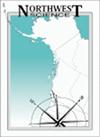阿拉斯加东南部幼龄锡特卡云杉-西铁杉林下林种生物量回归研究
IF 0.5
4区 环境科学与生态学
Q4 ECOLOGY
引用次数: 2
摘要
摘要量化森林下层生物量对于理解生态过程很重要,但在阿拉斯加东南部,很少有无损测量下层生物量的方法。我们开发了年轻生长的锡特卡云杉(Picea sitchinsis)-西部铁杉(Tsuga heterophylla)林中常见林下物种的覆盖生物量方程。2007年至2018年,在阿拉斯加东南部的威尔士亲王岛上,对35个年龄在10至67岁之间的林分采用了目测覆盖和破坏性测量生物量的采样方法。对42个种和其他属的生物量线性覆盖回归进行了拟合。除总生物量外,所有木本物种的回归均按部分(叶、枝条、木材)拟合。回归也适用于禾本科、蕨类、forb、灌木、树木和针叶树功能类。我们通过将这些回归应用于通加斯范围内的幼龄生长研究来证明这些回归的实用性,该研究是一个丰富的数据集,包含四个幼龄级的处理和未处理林分的林下覆盖测量结果。0至5年生的偶数龄林分的下层生物量大于15年生的林分。经过处理的林分(间伐等)比15年以上未经处理的林分具有更大的林下生物量、年生长量和碳含量。此外,在处理后的林分中,随着林分年龄的增加,生物量组成变得不那么木质。这些回归提供了一种估计林下生物量的方法,可用于评估森林功能,包括林下动态、野生动物栖息地和林分总碳。本文章由计算机程序翻译,如有差异,请以英文原文为准。
Biomass Regressions for Understory Species in Young-Growth Sitka Spruce–Western Hemlock Forests of Southeast Alaska
Abstract Quantifying forest understory biomass is important for understanding ecological processes, but there are few methods for non-destructive measurement of understory biomass in southeast Alaska. We developed cover-to-biomass equations for common understory species in young-growth Sitka spruce (Picea sitchensis)–western hemlock (Tsuga heterophylla) forests. A sampling method of visually estimating cover and destructively measuring biomass was used at 35 stands aged 10 to 67 years on Prince of Wales Island in southeast Alaska from 2007 to 2018. Linear cover to biomass regressions were fitted for 42 species and other genera. In addition to total biomass, regressions were fitted by part (leaves, twigs, wood) for all woody species. Regressions were also fitted for graminoid, fern, forb, shrub, tree, and conifer functional classes. We demonstrate the utility of these regressions by applying them to the Tongass-wide young-growth studies, a rich dataset with understory cover measurements from treated and un-treated stands in four young-growth age classes. Understory biomass was greater in 0- to 5-year-old even-aged stands than stands greater than 15 years old. Treated stands (thinned, etc.) had a greater understory biomass, annual growth, and carbon than untreated stands older than 15 years. Additionally, biomass composition became less woody with increasing stand age in treated stands. These regressions provide an approach to estimate understory biomass, which can be used for evaluation of forest functions, including understory dynamics, wildlife habitats, and total stand carbon.
求助全文
通过发布文献求助,成功后即可免费获取论文全文。
去求助
来源期刊

Northwest Science
环境科学-生态学
CiteScore
1.30
自引率
0.00%
发文量
23
审稿时长
>36 weeks
期刊介绍:
The pages of Northwest Science are open to original and fundamental research in the basic, applied, and social sciences. All submissions are refereed by at least two qualified peer reviewers. Papers are welcome from authors outside of the Pacific Northwest if the topic is suitable to our regional audience.
 求助内容:
求助内容: 应助结果提醒方式:
应助结果提醒方式:


